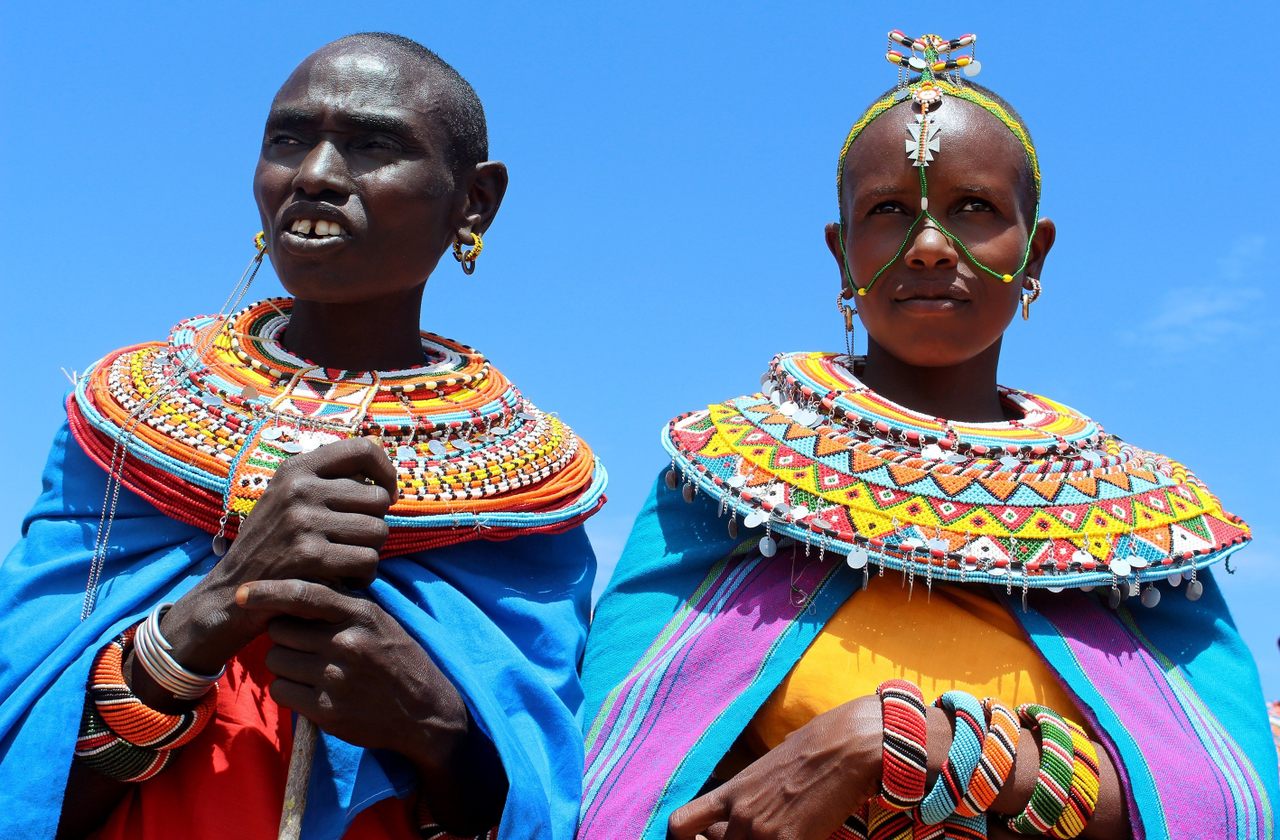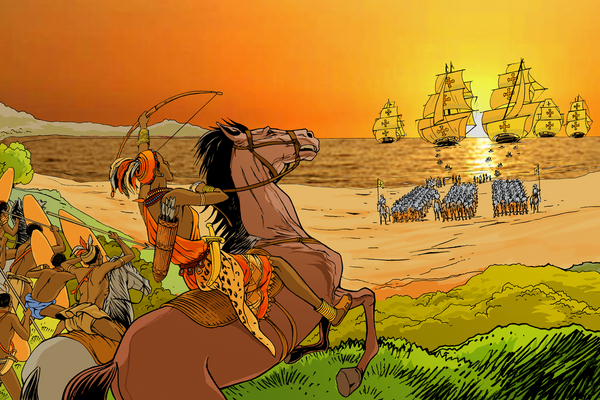Inside Kenya’s Women-Only Village Where Traditional Beaded Necklaces Are Symbols of Power
The women of Umoja no longer need a man to make their mporo marriage necklaces.
Thousands of glass beads colored cobalt, orange, emerald, and inky black sit in a bowl at Judia Lalampaa’s side. With the skill of a spider spinning prey, her long fingers dart between the bowl and the metal frame on her lap, twisting each bead into place with precision and purpose. The careful construction of a mporo, a traditional beaded necklace of Kenya’s Samburu people, has begun. It’ll take her all day to complete just this one, but its jewel-like beads tell stories descended from time immemorial: those passed from mother to daughter. She has to take her time.
Today Lalampaa wears several mporo necklaces from her vast personal collection, each displaying radiant hues of turquoise, green, luminous yellows, and more. “Each shade signifies something sacred to the Samburu,” she says as she runs her fingers through the bowl. For the Samburu, whose roots run deep throughout the north-central plains of Kenya, green is the symbol of grass, nourisher of cattle. A lighter green ensures a healthy pregnancy. White represents milk, on which all new life depends; bright blue brings energy. And dark blue is the most sacred of all—the symbol of Nkai, the Samburu god who dwells in the sky and blesses the people below with rain.
Lalampaa is one of many villagers living in Umoja, a tiny village nestled beside the Ewaso Ng’iro River in central Kenya. Umoja is much like its neighboring villages—but it’s unlike them in one important sense. “Umoja is a sanctuary for Samburu women,” Rebecca Lolosoli states with pride from beside Lalampaa. “Any woman in Kenya is welcome to live here as long as she wishes. But men are forbidden.” Lalampaa smiles.

Settled beneath the shade of a gnarled acacia, Lolosoli is the lion-hearted matriarch whose presence exudes as much defiance as the wizened tree that hovers over her. As Umoja’s founder, Lolosoli’s battle for equality began decades ago when she was gifted the beads for her own mporo marriage necklace by her then-husband. As per Samburu tradition, beads are gifted to young women by their betrothed so that they can begin their necklace collection. The more elaborate the gifted beads and subsequent necklace, the greater her husband’s wealth and status. But the women of Umoja no longer need a man to make their mporos. “We buy our own beads now,” Lolosoli says, “because we make our own money.”
After her marriage ceremony, Lolosoli endured continuous abuse from her husband. “To beat your wife is a symbol of masculine strength among the morans [young men],” she says. “My husband beat me and raped me. I fought back and told other women that they should not tolerate this treatment. Because of this, I was attacked even more. I had no choice but to leave.”
Lolosoli’s courage led her to found Umoja, which translates to “unity” in Swahili, in 1990, alongside a 14-strong team of other women whose goal was to achieve autonomy and economic agency. Word quickly spread. Women and young girls arrived seeking sanctuary from male violence, including that perpetrated by British colonial forces, as well as harmful cultural practices, such as female genital mutilation and child sexual slavery. Today, the survivors residing in this remote savannah region of Samburu county have built homes for the 50 or so women and children of Umoja, plus a school for infant boys and girls, and modern sanitary facilities. “Our goal is to make enough money to be able to send our women to higher education if they want to,” says Lolosoli.
In addition to donations received from charities and benefactors, the women of Umoja earn their living through the crafting of mporos, which they sell along the roadside. Ranging from around five dollars to $60, they’re a vital source of income. The necklace Lalampaa is working on will sell for $45—a premium price for the hefty work-in-progress measuring roughly 11 inches wide by 11 inches tall.

The use of beads for personal adornment in the region traces a dotted line through history. At the thousand-year-old burial sites of Nilo-Saharan communities, from which the Samburu are descended, beads honed from marine shells and animal bones were found. Excavations in modern-day Kenya uncovered 9th-century beads made from carnelian, agate, crystal, and coral, materials that were likely imported. Today, beads are sometimes crafted from painted seeds, such as those of the wild banana or whistling thorn. But by far the most popular material is glass, lending beads a variety of bright colors and tinkling acoustics. “The color and sound of the beads is important to us,” says Lolosoli. “Because we use the necklaces while we sing and dance.” A necklace’s sound is a vital consideration during its construction, and the larger the necklace, the louder its rustle and thus the better it is for Samburu celebrations, such as weddings and birthdays.
Beyond their use as an instrument, mporos can be harbingers of good luck, a statement of social status, or simply decoration. Traditionally, young Samburu boys receive a beaded armband, amulet, or headdress when they reach the right age for circumcision. Meanwhile, girls are often shrouded in cascading crimson necklaces from chin to chest. Gifted by an admiring moran, it signifies the commencement of a non-marital sexual relationship—one to which her parents consented, but not the girl herself. The relationship ends when menstruation begins—a woman now, she’s circumcised in preparation for marriage. This widely condemned practice of ‘beading girls’—sexual slavery marked by gifting young girls with red necklaces—is renounced in Umoja.
“Our daughters are protected from sexual slavery and female genital mutilation,” says Lolosoli. “We respect our tradition, and so we circumcise our sons safely and allow them to become a moran. But it’s important that dangerous practices against girls are removed from Samburu culture.”

The midday heat torches the ground underfoot, and children playing in a clearing nearby reluctantly retreat to the shade of the old acacia. Lalampaa, and the women around her, start to sing. In each song, a leader delivers a verse, which is followed by the whole group repeating it in unison. “They’re singing to their daughters, telling them to help their mothers with the cooking and cleaning,” Lolosoli translates. “And to their sons, telling them to respect their mothers and sisters.”
As the children harass their bead-working mothers, the latter lay their necklaces on the ground to finish later. Lalampaa ties a string to mark her progress and lifts a wriggling toddler into her lap. Across the yard, the sound of a rumbling car draws near a gate. As the car pulls into view, Lolosoli’s son waves from the driver’s side window. The manager of nearby Kalama Community Conservancy, Tom Lolosoli leads the charge in local wildlife conservation.
“My son lives in a different village,” Lolosoli explains, waving him closer. “At Umoja, our sons can stay until they reach manhood, but then, they are asked to leave and to find a new home. Their mothers are free to go with them if they want to, of course. And sometimes they do leave with them.”
As he climbs out of his car and into the sun, his resemblance to his mother is obvious. Lolosoli steadies her walking stick in the dust, ready to rise. As the sunlight pours through the acacia’s canopy onto her lined brow and glittering mporos, it’s clear the resilience lining her face is entirely of her own making.












Follow us on Twitter to get the latest on the world's hidden wonders.
Like us on Facebook to get the latest on the world's hidden wonders.
Follow us on Twitter Like us on Facebook